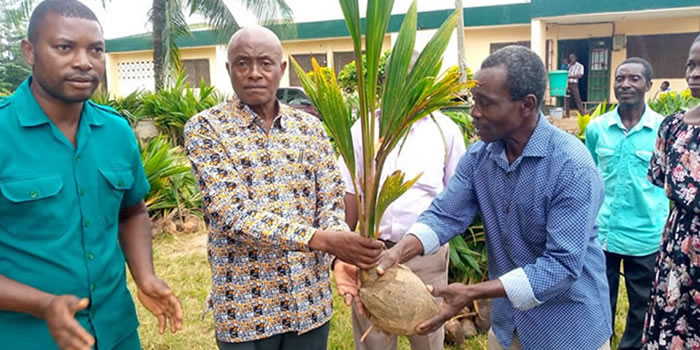

Education
Obtaining quality education is the foundation to creating Sustainable Development Goal four (4). In addition to improving quality of life, access to inclusive education can help equip locals with the tools required to develop innovative solutions to address their personal and societal problems.
The Abuakwa North Municipality has 203 schools, which comprises 110 public schools and 93 are private schools. Out of the 203 schools, there are 61 kindergartens, 70 Basic schools, 71 Junior High Schools and eleven (11) second cycle institutions consisting of 8 Senior High Schools and three (3) Technical Vocational and Education Training (TVET).
However, the Public sector dominate widely in almost all the levels except at the Kindergarten level and SHS/TVET level. The Municipal Assembly needs to pay critical attention to the Kindergarten level to build a proper foundation for lifelong learning.
Students Enrolment
The entire student’s enrolment in the municipality is 31,151 as of 2017/2018 academic year. Out of the 31,151 students, 18,825 are in the public schools representing 58.8% and 12,339 are also from the Private schools representing 41.2%. There is a drastic increment of enrolment at the primary level (10,627) as compared to the Junior High school (4,878) and Kindergarten level (4,850).
Staffing
The Abuakwa North Municipality recorded a total number of 1,633 teachers, comprising of 1,152 (70.6%) in the Public schools and 481(29.4%) also from Private schools. Out of the 1,163 teachers in the Municipality, 1,084 (66.4%) are trained teachers and 549 (33.6%) are also untrained teachers.
Out of the 1,084, 1,047 are from the public schools and 37 also from the private schools.
Infrastructure
The Abuakwa North Municipality still operates its educational Services from the Abuakwa South Municipal Education office in Kibi. This is due to lack of a building structure to be used as office for officers.
The 203 schools in the Municipality recorded 1,012 classrooms comprising of 540 and 472 classrooms in public schools and private schools respectively. Most of the classrooms in the private schools may not be in good conditions, and also will may not be permanent structure.
There are still public Basic schools in the municipality that runs the shift system. This is due to less number of furniture and conducive classrooms to accommodate the pupils for effective studies.
The current class size in Public KG is 25, Primary is 27 and JHS Schools is 29 students per class in the Municipality. This signifies that the Municipality has adequate number of classrooms to accommodate students in the KG, Primary and JHS level and the physical infrastructure available has to be renovated and furnished.
Pupil-Teacher Ratio (PTR) and Pupil Teacher Trained Ration (PTTR) In Public Schools
The Municipality generally recorded a pupil teacher ratio of 28:1, 20:1, 10:1, 24:1, 15:1 at the kindergarten, primary level, junior High school level, Senior High School level and TVET respectively. Though the ratios are lower than the national target of 35:1 at both KG and primary level, there are teachers who are handling more students than the national Target especially in the Public schools.
The Public schools in the Municipality recorded a pupil teacher trained ratio of 14:1, 22:1, 11:1, 22:1 and 19:1 at KG, Primary, JHS, SHS and TVET respectively.
Gender Parity Index
Girls’ education is a success Story in global development and National Policies like making Schooling in Senior High Senior and TVET free have led to drastic increase in school enrollment in Ghana.
The Municipality recorded 0.9 and 0.8 at the KG and primary level respectively; recording below 1.0 implies there are less number of girls than boys at these levels. The JHS level recorded 0.5 also meaning more boys are enrolled at this level as compared to girls.
Development of ICT Centres
Inadequate ICT facilities in the Municipality have been a major cause of concern. Available ICT centres are mostly privately owned and are not freely accessible to the youth. The the only ICT Centre at Tafo is being used by the Magistrate Court for want of space. It is equally worthy to note that most of the basic schools do not have electricity in order to benefit from ICT infrastructure. In the medium term the Assembly plans to place more emphasis on ICT education particularly at the basic education level by connecting electricity to schools without light and also incorporate ICT centre in new classroom blocks. In another development, schools with libraries are woefully inadequate as evident in Table 1.34 and call for the need to provide at least one Library Complex for each constituency to make it accessible to all.
Ghana School Feeding Programme is a government initiated policy that is aimed at feeding children at the Kindergarten and Primary School Levels. Over the years, the government has expanded the programme to cover Schools that were hitherto not covered under the programme.
Beneficiary Schools
There are Thirty (30) Schools with a total of 7,459 pupils within the Abuakwa North Municipality that are benefiting from the School Feeding Programme as shown in the table below;
Date Created : 3/25/2019 3:38:51 AM









 facebook
facebook
 twitter
twitter
 Youtube
Youtube
 +233 593 831 280
+233 593 831 280 0800 430 430
0800 430 430 GPS: GE-231-4383
GPS: GE-231-4383 info@ghanadistricts.com
info@ghanadistricts.com Box GP1044, Accra, Ghana
Box GP1044, Accra, Ghana